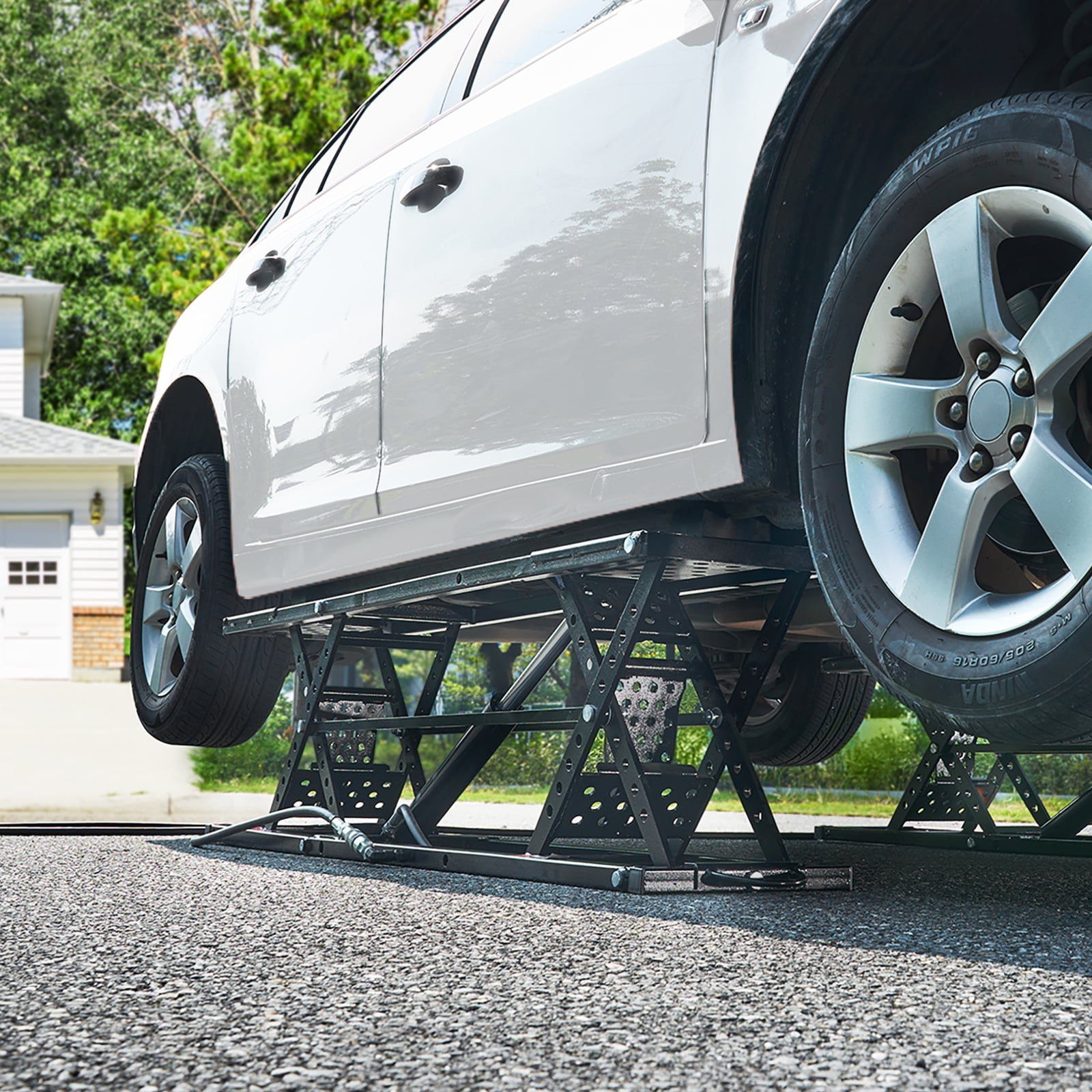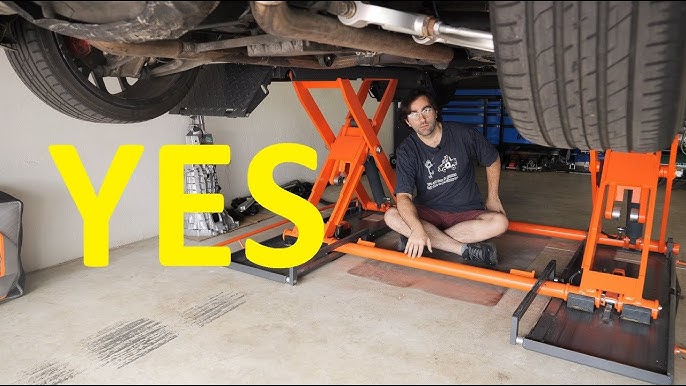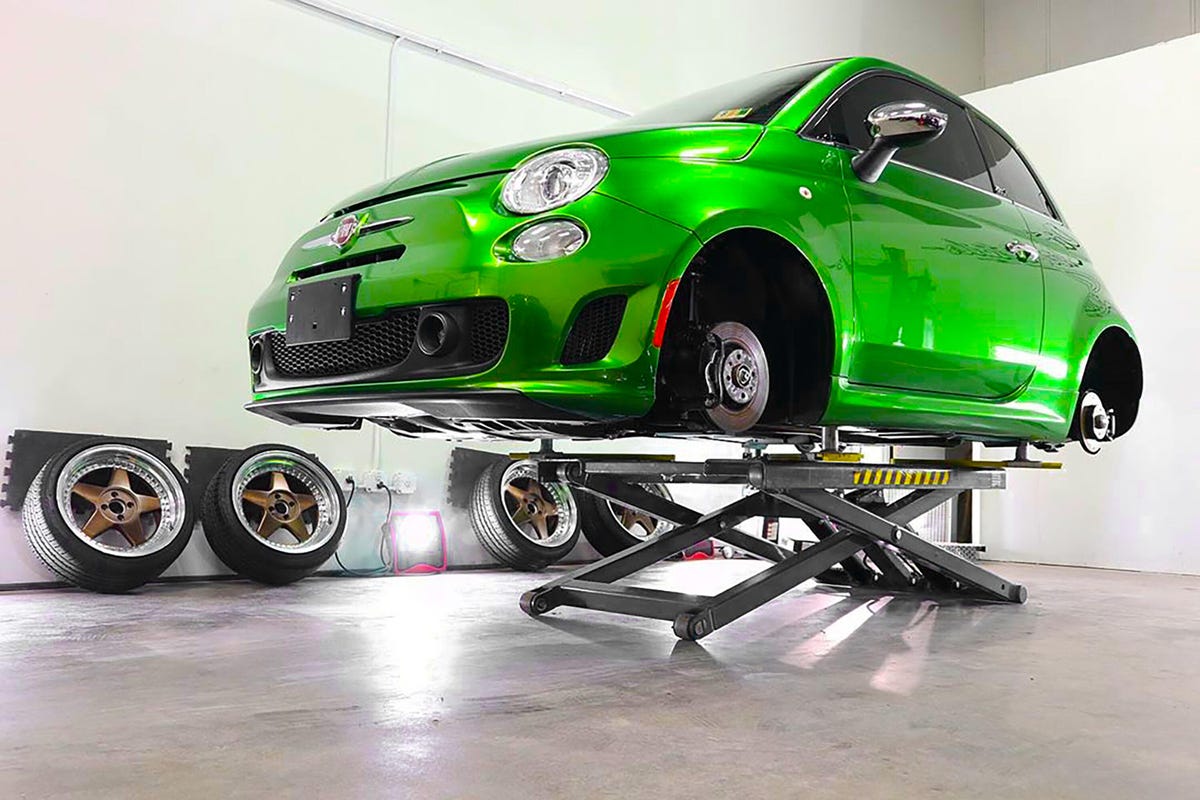Have you ever needed to lift your car at home but felt unsure about how to do it safely? You’re not alone.
Whether you’re changing a tire or performing routine maintenance, lifting your car correctly is crucial. If done wrong, it can lead to accidents or damage. But don’t worry—you’re about to learn how to lift a car at home safely and confidently.
Imagine having the power to fix issues with your car without always relying on a mechanic. With the right tips and tools, you can achieve this effortlessly. Keep reading, and discover the simple steps that will empower you to become your car’s best caretaker. Your safety and your car’s well-being depend on it.
This Article May Help You More: Best Portable Car Jack Kit for Tire Changing

Credit: www.walmart.com
Choosing The Right Equipment
Selecting the right tools ensures safety when lifting a car at home. Use a reliable jack and sturdy jack stands. Check all equipment for any damage before use.
Choosing the right equipment is crucial when it comes to lifting a car safely at home. Without the proper tools, you might find yourself in a precarious situation. It’s not just about getting the job done; it’s about doing it safely and efficiently. So, before you start, let’s ensure you have the right equipment to keep you secure and your car stable.
Types Of Jacks
When lifting a car, the jack you choose can make all the difference. Hydraulic floor jacks are popular for their ease of use and stability. They roll under your car and, with a few pumps of the handle, lift your vehicle smoothly. If you’ve ever struggled with a scissor jack on the side of the road, you’ll appreciate the hydraulic jack’s efficiency. Scissor jacks, often found in car trunks, are compact and portable.
While not as robust as hydraulic jacks, they can be perfect for quick tire changes. Bottle jacks offer a great lifting capacity in a small package, but their height might not suit all vehicles. Think about your specific needs and vehicle type before choosing.
Quality Matters
A jack is only as good as its quality. Investing in a high-quality jack might seem costly, but it’s a purchase that pays off in safety and durability. Consider the weight capacity and build material. Steel jacks are strong and durable, while aluminum ones are lighter and easier to maneuver. You wouldn’t want a jack that fails halfway through lifting your vehicle. Brands with a good reputation often offer warranties, which can give you peace of mind.
I once bought a cheap jack that buckled under the weight, teaching me the hard lesson that quality matters. Would you trust your life to a flimsy tool? In summary, choosing the right equipment involves understanding your needs and prioritizing quality. With the right jack, you’ll not only lift your car but also elevate your confidence in handling your vehicle safely.
Preparing Your Workspace
Before lifting a car, set up your workspace properly. Safety is crucial. A well-prepared area prevents accidents and ensures a smooth process. Focus on clearing the area and improving lighting.
Clearing The Area
Remove any obstacles around the car. Tools, debris, and other items can pose risks. A clutter-free space allows easy movement and access. Place items far from the lifting zone. This reduces the risk of tripping or damaging the car.
Lighting And Safety
Ensure your workspace is well-lit. Bright lighting helps you see clearly. Install extra lights if necessary. Proper lighting prevents errors and enhances safety. Safety gear is essential. Wear gloves and safety glasses. Protect yourself from potential hazards.
Positioning The Jack
Safety is key when lifting a car at home. Proper jack positioning ensures stability. Incorrect placement can lead to accidents. This guide helps you position the jack correctly.
Locating Jack Points
Every car has specific jack points. These are reinforced areas under the car. Check the car manual for their location. Usually, they are near the wheels. Look for small notches or marks. These indicate safe lifting spots.
Inspect the area before placing the jack. Ensure it is clean and free of debris. A firm connection between the jack and car is essential. This prevents slipping during lifting.
Avoiding Common Mistakes
Never place the jack on weak parts. Avoid areas like the car floor or exhaust. These parts can bend or break under pressure. Always use the designated jack points.
Ensure the ground is level and stable. An uneven surface can cause the jack to shift. Use a jack pad for better grip and protection.
Double-check the jack’s position before lifting. A small mistake can lead to big problems. Take your time to ensure everything is right.
Read More: Impact Wrench Vs Lug Wrench
Lifting The Car
Safely lifting a car at home requires careful planning and the right tools. Use a jack and jack stands for stability. Always ensure the car is on a flat surface to prevent accidents.
Lifting a car at home can be a daunting task, especially if you’re new to it. But, with the right tools and techniques, it becomes an achievable task. Whether you’re changing a tire or checking the undercarriage, knowing how to lift your car safely is crucial. Let’s dive into the step-by-step process and ensure you do it safely and effectively.
Step-by-step Process
Start by gathering the necessary tools. You’ll need a car jack and jack stands. Always use jack stands for support; never rely solely on a car jack. Find a flat, solid surface to work on. This ensures that the car remains stable while lifted. A driveway or garage with concrete flooring is ideal. Locate the jacking points on your vehicle. These are specific spots designed to bear the car’s weight when jacked.
Check your car’s manual if you’re unsure where they are. Position the car jack under the jacking point and start lifting. Do so slowly and steadily. This helps maintain control and prevents any sudden shifts. Once the car is high enough, slide the jack stands under the car. Make sure they’re positioned correctly under the support points. Lower the car gently onto the stands, ensuring they take the weight evenly.
Ensuring Stability
After positioning the car on the jack stands, give the car a slight nudge. This helps check if the car is stable. If there’s any wobbling, reposition the stands until the car is steady. Consider using wheel chocks for added safety. These small wedges placed behind the tires prevent any accidental rolling. It’s a simple step but adds an extra layer of safety. Maintain a clean working area around the car. Remove any tools or debris that might cause you to trip or fall. A clear space keeps your focus sharp and reduces risks.
Finally, double-check everything before you begin any work under the car. It’s better to be safe than sorry. Would you trust a wobbly ladder? The same principle applies here. Have you ever felt the anxiety of your car wobbling above you? By following these steps, you can lift your car with confidence and ensure a safe working environment.
Securing The Car
Securing the car is crucial when lifting it at home. Safety should always be your priority. Ensuring a stable environment prevents accidents. Follow these steps to secure your car properly.
Using Jack Stands
Always use jack stands after lifting your car. Jacks alone aren’t safe for holding the car. Place the jack stands under sturdy points. The owner’s manual can guide you. Double-check the stands are locked securely. This ensures the car remains stable.
Checking For Movement
After setting up the jack stands, check for any movement. Gently shake the car. It should not wobble or shift. Look for any signs of instability. If the car moves, readjust the stands immediately. Safety checks prevent potential accidents.

Credit: www.youtube.com
Troubleshooting And Safety
Lifting a car safely at home requires careful planning and the right tools. Ensure the car is on a flat surface and engage the parking brake. Use a reliable jack and jack stands to secure the vehicle before working underneath.
Always double-check the stability to prevent accidents.
Lifting a car at home can be a practical solution for many DIY enthusiasts and car owners. However, safety should always be your top priority. Understanding how to troubleshoot equipment failures and knowing what to do in an emergency can make all the difference in ensuring a safe experience.
Handling Equipment Failures
Even the best tools can fail. Imagine you’ve just started lifting your car, and the jack suddenly feels unstable. First, stop immediately and assess the situation. Is the jack placed on a level surface? Is it rated for your car’s weight? Double-check your equipment. A visual inspection can reveal cracks or wear on the jack or stands. Replace anything that looks compromised. Always have a backup plan, like a spare jack or stand, ready to go. Consider investing in high-quality equipment. It might cost more upfront, but it will pay off in peace of mind. Remember, your safety is worth the investment.
Emergency Procedures
What if your equipment fails completely while the car is lifted? This is a scary scenario, but knowing what to do can keep you safe. First, never attempt to get under the car if you suspect any failure. Call for help if needed. Having someone nearby when lifting your car can be invaluable. They can assist or call for professional help if things go wrong. Prepare for emergencies. Keep a phone within reach and have emergency numbers handy.
It’s also wise to have a fire extinguisher and first aid kit nearby. You never know when you’ll need them. Safety is not just about the right techniques—it’s about preparation and awareness. Are you ready to lift your car safely at home? Would you trust your equipment in a critical moment? Your answers can define your approach to car maintenance.
Maintenance Of Equipment
Maintaining your car-lifting equipment is crucial for safety. Regular upkeep ensures tools work efficiently. Well-maintained gear prevents accidents. It extends the lifespan of your tools. Proper maintenance saves money. It reduces the need for frequent replacements.
Regular Inspections
Inspect your lifting equipment often. Check for wear and tear. Look for cracks or damage. Examine all moving parts. Ensure nuts and bolts are tight. Replace any worn-out components promptly. Regular checks prevent unexpected failures. They ensure a safe lifting process.
Cleaning And Storage
Keep your tools clean. Remove dirt and grease after each use. Use a soft cloth and mild cleaner. Dry them thoroughly to prevent rust. Store equipment in a dry place. Avoid damp areas. Use protective covers if available. Proper storage extends the life of your tools.

Credit: www.cnet.com
Frequently Asked Questions
How Do I Safely Lift A Car At Home?
To safely lift a car at home, use a high-quality jack and jack stands. Always park on a flat surface and engage the parking brake. Position the jack under the car’s designated lift points. Never rely solely on the jack; use jack stands for additional support to ensure safety.
What Tools Do I Need To Lift A Car?
To lift a car, you need a hydraulic jack and jack stands. A wheel chock is also essential for safety. A creeper can help you work comfortably under the car. Ensure all tools are in good condition to prevent accidents.
Where Should I Place The Car Jack?
Place the car jack under the vehicle’s designated lift points. These are usually reinforced areas marked in the car’s manual. Incorrect placement can damage the vehicle and cause accidents. Ensure the jack is stable before lifting the car.
Can I Lift A Car Without Jack Stands?
Lifting a car without jack stands is unsafe. Jack stands provide stable support, preventing the car from falling. Relying only on a hydraulic jack can lead to accidents. Always use jack stands for your safety and peace of mind during car maintenance.
Conclusion
Lifting a car safely at home is not complicated. Follow safety guidelines closely. Use the right tools for the job. Always work on a flat surface. Double-check your setup before starting. Keep your workspace organized and clean. Ask for help if unsure about anything.
Protect yourself with gloves and goggles. Remember, safety comes first. Stay focused and alert during the process. Regular checks on your equipment are essential. With patience and care, your tasks become smoother. Practice builds confidence. Now, you’re ready to lift a car safely at home.
Disclosure: As an Amazon Associate, I may earn from qualifying purchases at no extra cost to you. Amazon and the Amazon logo are trademarks of Amazon.com, Inc, or its affiliates.

I am Sadman, the founder of CarSensorHub.com, where I share my passion for cars and technology. I specialize in writing detailed reviews and helpful guides on car gadgets, accessories, safety tools and many more. My mission is to help car owners discover the best products and tips to improve their driving experience and stay safe on the road.



